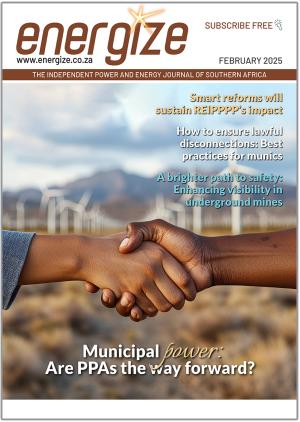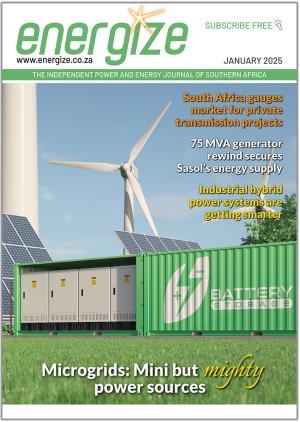In March 2023 civil society groups rejected the consultation process for the Koeberg life extension run by the National Nuclear Regulator (NNR), citing concerns about a lack of transparency. Those concerns are now vindicated as the threat of legal action has forced Eskom to release information that was previously being withheld from the public by both Eskom and the NNR.
Background
In 2021 Eskom applied to the NNR for a twenty year extension to the Koeberg life extension licence and was then required to prepare a Safety Case Report detailing why such an extension would be safe. The entire Koeberg structure has come to the end of its engineered design life and it has deteriorated faster than anticipated, according to Eskom.
Initially, at a Public Safety Information Forum meeting on 31 March 2022, Eskom stated that the Safety Case Report would not be made public. Eskom later backtracked on this position and in January 2023 when instructed by the NNR, released a version of the report. However, this version was highly and arbitrarily redacted, with blackouts over a myriad of phrases, sentences, paragraphs and in some cases several full pages in a row.
Also in January 2023, the NNR started a public consultation process asking the public to submit comments even though the public did not have access to the Safety Case Report. Instead, the NNR released a “Public Information Document” (PID) which contained what Eskom deemed “sufficient” information for the public to know. This PID excludes technical information and reads a bit like a sales brochure for nuclear power:
For example, it begins: “Koeberg has been producing clean and safe electricity for 38 years, conforming to industry standards, utilising internationally benchmarked management systems, and employing suitably qualified and authorised personnel.”
It also states: “the two Koeberg nuclear units are the only baseload electrical generating units in the southern part of the country. They help to stabilise the national electricity grid.” which contradicts what many experts have said. The CSIR recently stated it had modelled the South African electrical system and found that Koeberg was not necessary to stabilise the grid. Several experts have also spoken out about the very term “baseload generation” being outdated.
Civil organisations were unsatisfied with this PID, and accused Eskom and the NNR of colluding to keep critical information from the public. They claimed the public consultation process started by the NNR could only be considered meaningful if the public were fully informed.
Rodney Anderson, chair of Save Bantamsklip - an organisation founded to oppose the building of a nuclear plant at Bantamsklip near Hermanus - was one of those dissatisfied with the redactions and decided to submit a request under the Promotion of Access to Information Act (PAIA) to both Eskom and the NNR for the unredacted Safety Case Report.
The ‘Koeberg cracks’ report
Anderson has also long been concerned about the state of the two containment domes that enclose the two reactors at Koeberg since seeing an article by the Koeberg Alert Alliance (KAA) that revealed that Eskom had found a 110 metre crack right around the top of the unit 2 dome. In 2020 the KAA had submitted a PAIA application for the latest report on the state of the domes and were provided with a report of which some 50% of the contents were blacked out. Anderson therefore also submitted a PAIA request for the unredacted version of this report in June 2023, again both to Eskom as the author of the report, and the NNR as the custodians of nuclear safety.
Eskom replied to the PAIA request and provided the report, but once again with about half of it blacked out. Not satisfied, Anderson engaged law firm Chennells Albertyn who wrote formal appeals to both Eskom and the NNR detailing why the heavy redactions were not aligned with the PAIA, and why the missing information was important to release into the public domain.
In response to this appeal, on 1 September 2023 Eskom provided a complete copy of the ‘Koeberg cracks’ report, free of any redactions. In the version given to KAA blacked out sections were labelled with reasons, such as “Information that was considered to be an opinion, advice, report or recommendation was also redacted”, and “sensitive technical information redacted”. From the unredacted report provided to Anderson it became clear these reasons were untrue.
For example, pages 11 to 22 which were previously blacked out entirely can now be seen to be a table showing the history of issues with the containment buildings, and that there was no valid reason to redact them.
Anderson says he and other energy experts will be studying the document over the coming weeks. “This is a positive step towards transparency, however while we welcome the extra information that has now been revealed, it is disappointing to see that it is necessary to resort to lawyers' letters before Eskom and the NNR are forced to do what they should have done in the first place,” said Anderson.
“Why not be open and transparent with the public about issues relating to nuclear safety? It also has been demonstrated that Eskom has simply lied and abused the PAIA process to hide information from the public – safety information that we have every right to know.”
The redacted Safety Case Report for Koeberg
The initial response from Eskom to the PAIA request for an unredacted copy of the Safety Case Report was to once again provide a heavily redacted version of the report. As he did with the ‘Koeberg cracks’ report, Anderson instructed Chennells Albertyn to appeal to Eskom and the NNR.
This was done, and detailed letters were sent to both Eskom and the NNR explaining why the information was in the public interest, and must be released especially given the fact that the NNR was running a public consultation process about the safety of extending the life of the Koeberg plant.
In response to this appeal, Eskom did an about-face and provided a new version of the Safety Case Report. Not only was this a later version of the document (version 2 as opposed to version 1a previously released to the public) but it also lacked the shotgun redactions scattered throughout it. Apart from three small redactions, the most significant remaining redactions are appendices D2 and D3 which are blacked out in their entirety. These appear in the index as “D.2 Impact of Deviations on DiD Levels” and “D.3 Impact of Deviations on Fundamental Safety Functions”. DiD refers to Defense in Depth, which is having multiple systems to ensure that if one fails, there is not a catastrophic accident.
“We previously dismissed the so-called public consultation process run by the NNR as a sham, as all the information we required and requested was not made available to us,” said Anderson.
He believes that the fact that a report with much more accessible information has now been released, shows clearly that there was no valid reason to withhold it in the first place. “Initially we said please “Suspend, Don't Extend’,” said Anderson. “Now it is plain to see that we were correct in saying the original process was invalid. To drip feed information as the public consultation process unfolds is entirely unacceptable. Now that more complete information has been released, a fresh public consultation process must be restarted.”
What next?
The full ‘Koeberg cracks’ report on the damage to the containment structures from 2018 is now available to independent experts who can check the extent of the damage that was detected at that time, and then be able to also analyse the Safety Case Report to check if it includes plans for all corrective measures which are needed.
With regard to the latest version of the Safety Case Report, Anderson intends to release the latest report he received from Eskom and simultaneously he will be challenging the remaining redactions in the document.















